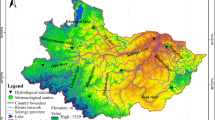Abstract
The Tarim River basin, China, is a typical arid inland river basin in China. Management of water resources and agricultural development rely heavily on the understanding of droughts. In this study, an integrated drought index is proposed, based on the Standardized Precipitation Evapotranspiration Index and the Standardized Runoff Index, and then the changing properties of drought regimes have been analyzed using a Markov Chain model. Results indicate that: (1) the Kaidu and Aksu Rivers are dominated by prompt transition between hydrological and meteorological droughts. Long-lasting droughts heavily impact agricultural development in the Kaidu and Yarkand River basins; (2) the Kaidu and Aksu River basins are influenced mainly by hydro-meteorological droughts and hydrological drought is dominant in the Yarkand River basin; (3) different drought conditions are the results of different sources of river runoff. Increasing precipitation alleviate droughts in the Tarim River basin. However, a drying tendency can still be found in the Kaidu River basin; (4) higher probability is detected for the transition from both meteorological and hydrological wet to both meteorological and hydrological dry, implying that the Tarim River basin is sensitive to both meteorological and hydrological droughts. Results of this study are of practical value for the regional management of water resources, planning of agricultural irrigation, and measures for mitigation of hydrological and meteorological droughts.










Similar content being viewed by others
References
Bai Y, Xu H, Ling H (2014) Drought–flood variation and its correlation with runoff in three headstreams of Tarim River, Xinjiang, China. Environ Earth Sci 71(3):1297–1309
Beguería S, Vicente-Serrano SM (2013) SPEI: calculation of the standardised precipitation-evapotranspiration index. http://CRAN.R-project.org/package=SPEI
Chen YN, Li WH, Xu CC, Hao XM (2007) Effects of climate change on water resources in Tarim River Basin, Northwest China. J Environ Sci 19:488–493
Droogers P, Allen R (2002) Estimating reference evapotranspiration under inaccurate data conditions. Irrig Drain Syst 16(1):33–45
Eyton JR (1984) Complementary-color, two-variable maps. Ann Assoc Am Geogr 74(3):477–490
Hargreaves GH (1994) Defining and using reference evapotranspiration. J Irrig Drain Eng 120(6):1132–1139
Jiang FQ, Hu RJ, Wang YJ, Huang YY, Wang SD (2003) Response of extreme flood events to potential climate change from warm–dry to warm–wet in Xinjiang. J Nat Disasters 12:141–146 (in Chinese)
McKee TB, Doesken NJ, Kleist J (1993) The relationship of drought frequency and duration to time scales. In: Eight conference on applied climatology, Anaheim, California
Mishra AK, Singh VP (2010) A review of drought concepts. J Hydrol 391(1–2):202–216
Niemeyer S (2008) New drought indices. Options Mediterranéennes 80, Series A
Qian WH, Lin X (2005) Regional trends in recent precipitation indices in China. Meteorol Atmos Phys 90:193–207
Sharma BR, Minhas PS (2005) Strategies for managing saline/alkali waters for sustainable agricultural production in South Asia. Agric Water Manag 78:136–151
Shi RJ (1992) Fundamentals of Markov China and applications. Xi’an: Xi’an Electron University of Science and Technology Press (in Chinese)
Shi YF (2003) Evaluations of shifts from warm–dry to warm–humid climate in the northwest China. Meteorology Press, Beijing (in Chinese)
Shukla S, Wood AW (2008) Use of a standardized runoff index for characterizing hydrologic drought. Geophys Res Lett 35:L02405. doi:10.1029/2007GL032487
Sun P, Zhang Q, Lu XX, Bai Y (2012) Changing properties of low flow of the Tarim River basin: possible causes and implications. Quat Int 282:78–86
Tao H, Borth H, Fraedrich K et al (2014) Drought and wetness variability in the Tarim River Basin and connection to large‐scale atmospheric circulation. Int J Clim 34(8):2678–2684
Tokarczyk T, Szalińska W (2013) Combined analysis of precipitation and water deficit for drought hazard assessment. Hydrol Sci J 59(9):1675–1689
Vicente-Serrano SM, Beguería S, López-Moreno JI (2010) A multiscalar drought index sensitive to global warming: the Standardized Precipitation Evapotranspiration Index. J Clim 23(7):1696–1718
Wang W, Zhu Y, Xu R (2015) Drought severity change in China during 1961–2012 indicated by SPI and SPEI. Nat Hazards 75(3):2437–2451
Wen KG (2005) Encyclopedia of meteorological disasters in China. Meteorological Press, Beijing (in Chinese)
Wilks DS (2006) Statistical methods in the atmospheric sciences, 2nd edn. Academic Press, London
Xu HL, Ye M, Li J (2008) The water transfer effects on agricultural development in the lower Tarim River, Xinjiang of China. Agric Water Manag 95:59–68
Zhang Q, Xu C-Y, Tao H, Jiang T, Chen YD (2010) Climate changes and their impacts on water resources in the arid regions: a case study of the Tarim River basin, China. Stoch Environ Res Risk Assess 24(3):349–358
Zhang Q, Singh VP, Li JF, Jiang FQ, Bai YG (2012a) Spatio-temporal variations of precipitation extremes in Xinjiang, China. J Hydrol 434–435:7–18
Zhang Q, Li J, Singh VP (2012b) Application of Archimedean Copulas in the analysis of the precipitation extremes: effects of precipitation changes. Theor Appl Climatol 107(1–2):255–264
Zhang Q, Li JF, Singh VP, Bai Y (2012c) SPI-based evaluation of drought events in Xinjiang, China. Nat Hazards 64(1):481–492
Zhang Q, Li JF, Singh VP, Xiao M (2013) Spatio-temporal relations between temperature and precipitation regimes: implications for temperature-induced changes in the hydrological cycle. Global Planet Change 111:57–76
Acknowledgments
This work is financially supported by Xinjiang Science and Technology Project (Grant No.: 201331104), National Science Foundation for Distinguished Young Scholars of China (Grant No.: 51425903), Natural Science Foundation of Anhui province (Grant No.: 1408085MKL23) and is fully supported by a grant from the Research Grants Council of the Hong Kong Special Administrative Region, China (Project No. CUHK441313). Our cordial gratitude should be extended to the editor, Prof. Dr. George Christakos, and anonymous associate editor, three anonymous reviewers for their professional comments and pertinent revision suggestions which are greatly helpful for further improvement of the quality of this manuscript.
Author information
Authors and Affiliations
Corresponding author
Rights and permissions
About this article
Cite this article
Sun, P., Zhang, Q., Singh, V.P. et al. Transitional variations and risk of hydro-meteorological droughts in the Tarim River basin, China. Stoch Environ Res Risk Assess 31, 1515–1526 (2017). https://doi.org/10.1007/s00477-016-1254-2
Published:
Issue Date:
DOI: https://doi.org/10.1007/s00477-016-1254-2




